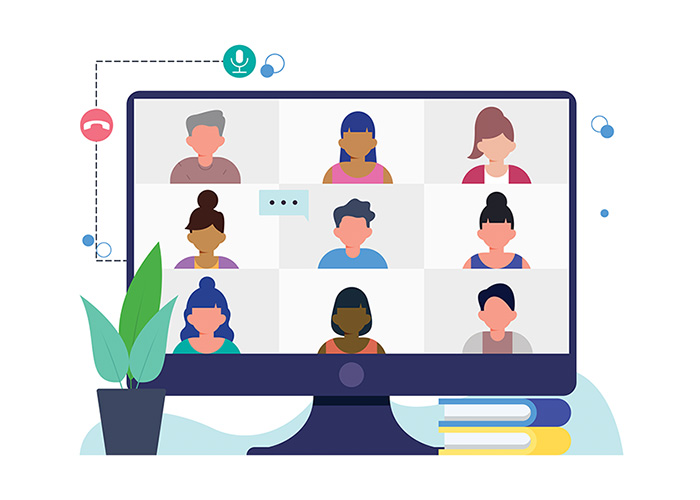How To Be a Zooming Success
With virtual meetings and hybrid arrangements likely to remain standard practice, this primer is bound to come in handy.
BY ROBIN QUINVILLE

Deemka Studio / Shutterstock
I confess: In the deputy chief of mission (DCM) course, I multitasked during media training. Why? Because the U.S. ambassador to Germany was a media professional. I knew one thing for sure: I would never have to go on camera.
Big mistake. My cozy thought bubble burst when the ambassador left for a new job in February 2020, and COVID-19 arrived. Suddenly, everything we did was on camera: staff meetings, town halls, policy discussions with government officials, public speeches, media interviews. Sure, there were times we could get together (small groups in big rooms). But for the most part, the pandemic meant our work—in all its facets—was filtered through our screens.
The Foreign Service adapted. So did our contacts in the governments and organizations we work with. Formality slipped away as some of our starchiest overseas colleagues suddenly turned up from their living room, relaxed in a polo shirt and jeans, for a vibrant bilateral debate. What mattered was keeping our dialogue going. We were navigating new cultural norms together.
We flexed, we adjusted, we learned. And we realized: We can do better. So as we look ahead to the next stage (hybrid model, anyone?), here are five hard-earned lessons to help us be a zooming success.
Set the Stage
In real life, we make sure to know the run-of-show before we head to the event. How many attendees? Will we speak from a podium or in a conversational format? Seated at a table? Who are the other speakers? Will the host collect and select the questions?
We need the same answers for events in the virtual world. How many folks will be on screen? Just the speaker and host? A “panel” of five? Are presenters speaking off the cuff, or delivering prepared remarks? For an international or overseas audience, what language is expected? Do the organizers have a logo backdrop they want you to insert electronically? What does it look like, and do we want to promote their brand or our own?
Is this “just” a live transmission, or will the organization record it and post it? Do we agree? Are we expected to monitor the “chat” function, or will the host? If it’s a meeting with an official, who else is in the (virtual) room?
It is no fun to find this stuff out after joining the event! Organizers will appreciate the advance preparation; it improves their own planning. And we can concentrate on the message we want to deliver.
You’re Not on Screen, You’re on TV
At the pandemic’s start, we were self-satisfied with our plucky little home office setups. We mastered several online platforms. We got used to odd angles and shadowed faces. It wouldn’t be for long, right?
Wrong. So now it’s time to raise our production values. Remember: Someone somewhere may be streaming your event to their TV. That person can count your freckles if they’re bored. Even on a small screen, they’ll be checking out the décor and bookshelves behind you. It’s not nosy; it’s human.
Blur the room or drop in an electronic background. Then the audience will concentrate on you, not your collectibles.
Check the lighting. Can people see your face, as they would in a meeting? I once tuned in to an event featuring three of my friends. One looked great; the others looked like they’d completed a couple of back-to-back tours in war zones. The difference? One had a ring light. So if your home office has weird lighting, take action. If the audience can’t see you, their attention will wander.
Be your own costume department! It’s a professional meeting, so dress professionally. If you’re a featured speaker, the organization will likely take screen shots for Twitter or Instagram during the event. My one concession to a home office: no shoes for virtual meetings. I’m from California; it’s my birthright.
You’re an Actor, Sort Of
Engaging with others online means projecting ourselves way more than in a normal office meeting. This is why a day full of virtual meetings is so tiring! Our screens are both broadcaster and barrier. We have to constantly show engagement and be fully present.
Be an active listener and watch closely for visual cues. Make sure you’re providing some, too. When giving a speech or leading a discussion, we need to be as concerned about holding the audience as in real life. The stakes are higher in the virtual world: The audience can log off, and we’ll never know they’re gone.
Treat Zoom as a Room
When meeting virtually, think of Zoom as a room. Let’s—mentally—be in an executive office. That means no multitasking. Even off camera, we should hold back from checking email, messages and all of our alternate devices. Phones should be on silent.
If staff members are “accompanying” us to a virtual meeting, they need to stop multitasking, too. That way, they’re ready to add their expertise to the discussion. It’s how we’d operate in real life, right? Even if the person on the other side of the screen is distracted, we’ll look organized, and our respect will be appreciated.
Keep Calm and Carry On
This phrase—originated in London during the Blitz—is my mantra when things go wrong. Which they will; you’ve already lived through months of online disasters and near misses. It helps to think ahead, log in 30 minutes early in case of technical issues, and have a backup plan for when things go wrong. Like:
• It’s a shark-tank contest, and folks will be making their pitch to you and other judges. You need to hear it all to make a fair judgment. Schedule someone from your organization to monitor online; if your participation suddenly drops, you’ll be alerted and given some practical advice on how to reconnect. Keep calm and carry on.
• You’ve logged in early. The organizer’s technician has put you in a virtual “side room,” promising to retrieve you when it’s your turn. You hear the moderator introduce you, but the screen shows you’re still off camera. Keep calm, carry on, start talking!
The technical error is their problem. They’ll let you know if they want you to stop. When this happened to me, the audience could hear but not see me. It was tougher for the speaker they could see but not hear.
• There’s stuff accumulating in the “chat,” but you’re busy speaking and interacting with the host. Keep your eye on the camera and focus on the host. Ideally, you’ve anticipated this issue and have arranged with the organizers to have someone monitor the chat and put questions to you. If no arrangements are in place, keep calm, carry on and ignore the chat. Once you’ve finished speaking, ask the host how to handle comments there.
• The screen goes blank. You can’t see the folks who were on screen just a few minutes before. But you can hear them, so you know your meeting is continuing. Keep your eyes on the camera, continue to engage, and only correct the technology if you absolutely have to.
• Zoom or Webex or Microsoft Teams worked from your device yesterday—but not today, when the event is starting. Have an alternate device ready just in case.
• The fire alarm goes off in your building. Thirty-five CEOs are in a virtual meeting with you. Don’t burn! If you are the featured speaker, you have planned ahead and asked one of your stellar staff to participate with you. Hand the meeting off to that person, vacate the building, return if there’s no crisis. You’ll win points by showing you can keep calm and carry on.
Read More...
- “Can Diplomacy Be Done Virtually?” by Jessica Huaracayo and Alexis Ludwig, The Foreign Service Journal, April 2021
- “For global diplomats, Zoom is not like being in the room,” by Ryan Heath, Politico, April 16, 2020
- “Digital Diplomacy—Will State Ever Take the Plunge?” by Amelia Shaw, The Foreign Service Journal, May 2017




